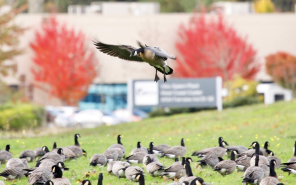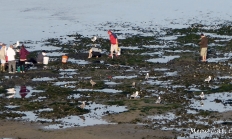
Search myodfw.com

A box calls is the most popular turkey call, and is a good choice for new turkey hunters. Box calls not only are easy to use, but they can sound very realistic. A box call can create a wide range of yelps, clucks, purrs, fighting purrs, cackles and gobbles. If you can get yelps, clucks and purrs to sound good on a box call, you’ll routinely bring in birds. Parts of a box call Box calls come in two parts – a narrow rectangular box with a paddle attached at one end. Attached with a single screw in the center


Officials urge public to avoid contact with sick or dead birds as avian flu persists across Oregon
SALEM, Ore. – People across Oregon are being urged to avoid contact with sick or dead birds as highly pathogenic avian influenza (HPAI) continues to impact wild and domestic bird populations across the state. There is currently no effective treatment for wild and domestic birds, and the virus can…

New pilot program for limited entry parking at Sauvie Island Beaches Free pass required summer weekends and holidays starting July 4
SAUVIE ISLAND WILDIFE AREA, Ore.— To manage ongoing traffic and parking problems at Sauvie Island Wildlife Area's beaches, ODFW is introducing a new limited-entry parking pilot program. Starting July 4, vehicles will need a free Sauvie Island Beaches Pass in addition to the Wildlife Area Parking…
Fungus that causes white-nose syndrome in bats detected for first time in Oregon
SALEM, Ore.— The fungus that causes white-nose syndrome in bats has been detected in Clatsop County. White-nose syndrome is an infection in bats caused by the fungus Pseudogymnoascus destructans that disrupts hibernation, causing dehydration and starvation. Samples analyzed by U.S. Geological…

Build bird houses for ODFW. Teach families to fish. Walk a stream or hike in a forest looking for animals or sign of animals to support various studies. Teach others to hunt or about hunter safety. Assist Marine Reserves with onshore or offshore studies. These are just some of the things ODFW volunteers do to help protect and enhance Oregon's natural resources. Current volunteer opportunities


Oregon and Washington trying a new approach to 2026 sturgeon fisheries in the Columbia River upstream of Bonneville Dam; season will not open Jan. 1 in Bonneville and The Dalles pools
CLACKAMAS, Ore. – Sturgeon retention will not open in Bonneville and The Dalles pools on the traditional date of Jan 1. following a joint state hearing held by Oregon and Washington fishery managers today. However, the retention fishery in the John Day pool, where harvest rates have been stable and…

Following droughts in the 1930s that affected most of North America, major conservation efforts, both private and governmental, were enacted to reverse trends of degrading and disappearing wetlands. During this time period there was a major creation and expansion of Federal refuges and State wildlife areas. As the concept of waterfowl flyway management was endorsed and developed, wildlife areas were acquired and managed as part of a larger plan focused on migratory waterfowl needs. Klamath Wildlife Area was one of several wetland-focused wildlife areas established in Oregon. KWA was established in 1958, with primary objectives of protecting and improving waterfowl
Pot calls, often called slate calls, are friction-style calls that are easy to use and produce a range of turkey sounds. Parts of a pot call A pot call consists of three parts: a pot, a calling surface and a striker. The pot holds the slate and acts as a sound chamber. There are holes drilled in the bottom for sound to escape. To keep from covering the holes, hold the pot with the tips of your fingers, keeping it away from the palm of your hand. Pot calls can be made to be all-weather, with the right striker. The

Summer Lake Wildlife Area was established in 1944, with primary objectives of protecting and improving waterfowl habitat and providing a public hunting area. It is now a popular destination for hunting, wildlife viewing and environmental education due to its geographic setting, the abundance of wildlife present and species diversity.

Chris Kern, Region Manager Fisher research in southern Oregon Fisher are a Species of Greatest Conservaion Need in Oregon's State Wildlife Action Plan, and ODFW is actively conducting research to understand fisher occupancy and distribution east of I-5, as well as that of their competitors and predators. Wildlife Research staff maintained 30 baited camera traps in the Cascade-Siskiyou National Monument and Southern Cascades. The cameras were deployed in mid-September on U.S. Forest Service and Bureau of Land Management lands in areas with proposed habitat management efforts. The goal is to evaluate how these land alterations influence changes in mesocarnivore occupancy

